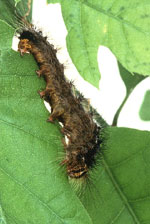Threats to Birds - Gypsy Moth (Lymantria
dispar)
Overview The gypsy moth is one of the most destructive pests of shade, fruit, and ornamental trees throughout the northern hemisphere, and defoliating millions of acres of trees annually. Repeated defoliation of trees can lead to their death. The gypsy moth was introduced to Massachusetts in 1869 in an attempt to develop a strain of silk moth resistant to disease. Since then, it has spread north to Canada, west to Wisconsin, and south to North Carolina.
Despite numerous state and local control efforts, it continues to spread west and south. Gypsy moths feed on over 500 varieties of trees and scrubs, including oak, alder, Douglas fir, and western hemlock. It caused an estimated $764 million in losses to the U.S. timber industry in one year. Gypsy moths occur in natural and artificial forests, riparian areas and urban areas. Outbreaks occur in stands where the primary hosts such as oak and poplar comprise greater than 20% of the basal area. In most years, the gypsy moth remains at low densities and causes no detectible damage, but occasionally, populations reach high densities and may completely defoliate host trees. Outbreaks typically last one to five years.
Description
The small grayish black hairy caterpillars hatch from eggs during the bud break in mid-spring, and enter the pupal stage in mid-summer. Adult male moths are brownish-gray, and the females are white with black markings. The males can fly but the females are flightless. The females lay buff-colored, oval-shaped egg masses containing 100 – 1500 eggs on the undersides of tree limbs, bark, rocks, and man-made structures.
Birds Affected
Migratory and resident forest birds.
Control
Aerial spraying is the most common method for eradicating new isolated populations and is also used to supress outbreaks in well established populations. Synthetic insecticides include diflubenzuron and carbaryl. The microbial pesticide, Bacillus thuringiensis or Bt is most commonly used in aerial and ground-based spraying.
Long-distance spread occurs when egg masses are unknowingly transported from infested areas on vehicles. If you travel to areas with gypsy moth infestations, take care to clean your car and other possessions before leaving the area. Manually remove egg masses from trees and shrubs in your yard. |
